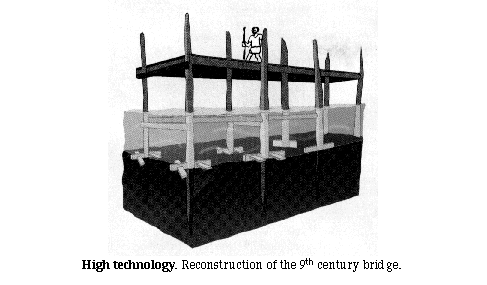|
Irish Bridge Sheds Light on Dark Ages by Sean Duke a science writer in Dublin
The vaunted engineering skills that the Romans spread across Europe are
supposed to have vanished during the "Dark Ages" - from the collapse of the
Roman empire in the fifth century until about A.D. 1000. But a new find in the west of
Ireland is challenging that assumption. A pair of underwater archaeologists has discovered
the remains of a huge wooden bridge across the river Shannon. At 160-meters long, it my be
the largest wooden structure from the early medieval period ever found in Europe, and its
technical complexity has surprised archaeologists. Researchers now believe that the
bridge, dated at A.D. 804, was the work of monks from the nearby town of
Clonmacnoise, who
kept Roman expertise over the centuries.

"The Clonmacnoise bridge fills an important gap," says
archaeologist John Bradley of the National University in Maynooth. "There was no
evidence, of large bridges in Europe between the Roman era and about A.D. 1000." It
is unlikely to be the last such discovery, adds Morgens Schou Jorgensen of the National
Museum of Denmark, an expert on the large wooden bridges built by the Vikings several
centuries later. "I think that other similar bridges will now be found in Ireland, as
happened in Denmark after the first Viking long bridge was uncovered in 1932," says
Jorgensen. If so, the finding could mean that a sophisticated land communications network
may have been in place across Ireland in the 9th century.
Donal Boland and Mattie Graham, divers who specialize in underwater
archaeology, had begun their survey of the river Shannon after coming across an intriguing
reference to abridge in the Annals of Clonmacnoise, written in 1158. They
concentrated on a 500-meter stretch of the river near the remains of the monastery. In
1994, with archaeological guidance from Fionnbarr Moore of the National Monuments Service
of Ireland, they found what they were looking for: an ancient oak post sticking out of the
muddy riverbed. By last fall, Boland and Graham had discovered a total of 130 timbers, all
nearly arranged in pairs 5 meters apart, spanning the entire 160-meter width of the
Shannon. They also found nine oak dugout canoes, from which workers may have driven the
pilings deep into the riverbed, and the remains of an elaborate horizontal cross-bracing
system that once supported a roadway.
The line of the posts ran directly into the ruins of a13th century
Norman castle, leading the researchers to suspect at first that the bridge was also a
Norman construction. But this theory was ruled out after they sent samples of the oak
timbers to Queen's University Belfast for dating by tree-ring analysis. The Belfast
researchers, led by Mike Bailie, said the timbers were felled in 804, a full 365 years
before Norman invaders arrived from France.
The focus of archaeologists then turned to the thriving 9th century
monastic settlement at Clonmacnoise. The town of several thousand inhabitants straddled
the point where an east-west route across Ireland known as the Eiscir Riada or Esker Read,
crossed the Shannon. "The bridge was built to attract commerce" says Aidan
O'Sullian the archaeological director in charge of Clonmacnoise, "and the leadership
for the project was probably provided by the monks."
The discovery of the Clonmacnoise bridge has led archaeologists said,
as Bradley to question whether knowledge was really lost in the aftermath of the fall of
Rome, at least in distant parts of Europe that were spared the chaos of the Dark Ages.
"We know the Irish preserved Roman texts, and this find suggests that they may also
have preserved Roman technology and bridge building skills," says Bradley.
"Perhaps the Dark Ages were not so dark after all."
This website was originally
developed by
Charles Camp for
CIVL
1112.
This site is maintained by the
Department of Civil Engineering
at the University of Memphis.
Your comments and questions are welcomed.
|



